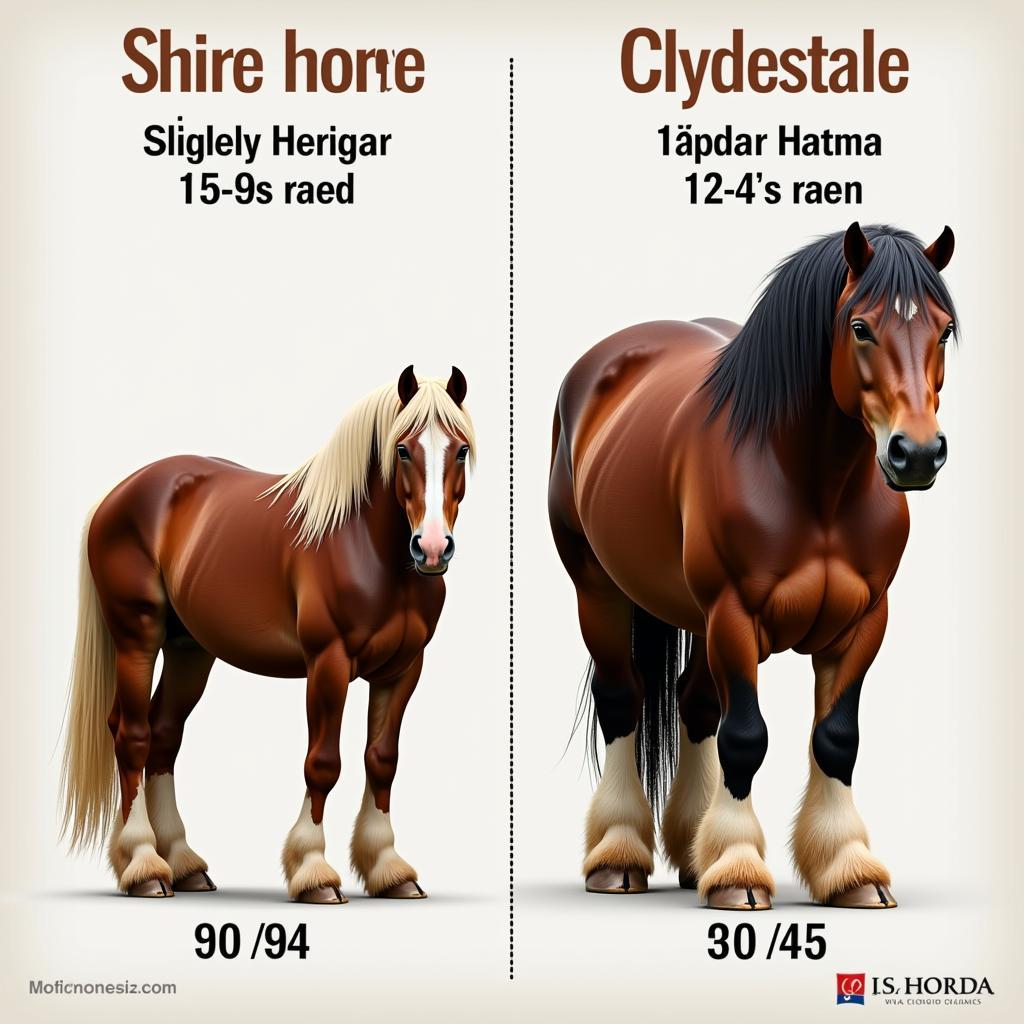Shire horses next to Clydesdales offer a breathtaking sight, showcasing the magnificence of these gentle giants. Both breeds are renowned for their impressive size, strength, and gentle nature. This article will delve into the similarities and differences between Shire horses and Clydesdales, exploring their history, physical characteristics, temperament, and modern-day roles.
Distinguishing Between Shire Horses and Clydesdales
While both breeds share a striking resemblance, there are key differences that set Shire horses and Clydesdales apart. Understanding these distinctions can help appreciate the unique qualities of each breed.
Size and Build: A Tale of Two Giants
Shire horses are generally considered the largest horse breed, often exceeding Clydesdales in height and weight. While both breeds boast impressive feathering on their lower legs, Shires tend to have more extensive feathering. Clydesdales are often slightly finer boned, giving them a more elegant appearance.
 Shire Horse and Clydesdale Size Comparison
Shire Horse and Clydesdale Size Comparison
Coat Color and Markings: Subtle Variations
Both Shire horses and Clydesdales exhibit a variety of coat colors, including bay, black, brown, and grey. However, Clydesdales are more commonly known for their bay coat with distinctive white markings, including a blaze on the face, four white socks, and often splashes of white on the body. Shires, while also displaying white markings, have a wider range of acceptable coat colors.
Temperament: Gentle Giants at Heart
Both breeds are known for their calm and gentle dispositions. Their docile nature makes them well-suited for various activities, from pulling carriages to participating in therapeutic riding programs.
 Shire Horse and Clydesdale Temperament
Shire Horse and Clydesdale Temperament
A Look Back: The History of Shire Horses and Clydesdales
Understanding the history of these breeds provides insights into their development and current characteristics. Both breeds share a common ancestor in the “Great Horse” of medieval times, bred for strength and size to carry knights in armor.
Shire Horses: England’s Gentle Giants
Shire horses originated in England, where they were originally bred for agricultural work and hauling heavy loads. Their immense strength and stamina made them invaluable assets on farms and in industries requiring heavy lifting.
Clydesdales: Scotland’s Pride
Clydesdales hail from Scotland, where they were also used for farm work and transportation. They gained popularity during the Industrial Revolution, playing a crucial role in transporting goods and materials.
Modern Roles: Beyond the Plow
While still occasionally used for traditional farm work, both Shire horses and Clydesdales have found new roles in modern society. They are popular choices for driving competitions, parades, and ceremonial events. Their gentle nature also makes them excellent therapy animals.
Conclusion: Celebrating Two Majestic Breeds
Comparing a Shire horse next to a Clydesdale highlights the subtle yet significant differences between these two majestic breeds. While Shires generally surpass Clydesdales in size, both share a gentle nature, rich history, and a continued presence in our modern world. Understanding these distinctions allows us to appreciate the unique qualities of each breed and celebrate their contributions to equine history and culture.
FAQ
- What is the main difference between a Shire horse and a Clydesdale? Shire horses are generally larger and have more feathering on their legs.
- Which breed is stronger? Both breeds are incredibly strong, but Shires are often considered the strongest.
- Are Shire horses and Clydesdales good for beginners? While gentle, their size requires experienced handling.
- What are Clydesdales famous for? Their iconic bay coat with white markings and their role in the Budweiser commercials.
- What are the best uses for Shire horses today? Driving, showing, and therapy work.
- Are these breeds expensive to maintain? Their size necessitates higher costs for feed, bedding, and farrier services.
- Where can I learn more about these breeds? Breed associations and online resources offer valuable information.
Need help with your horse or other pets? Contact us at Phone Number: 0772127271, Email: [email protected] Or visit us at QGM2+WX2, Vị Trung, Vị Thuỷ, Hậu Giang, Vietnam. We have a 24/7 customer service team.